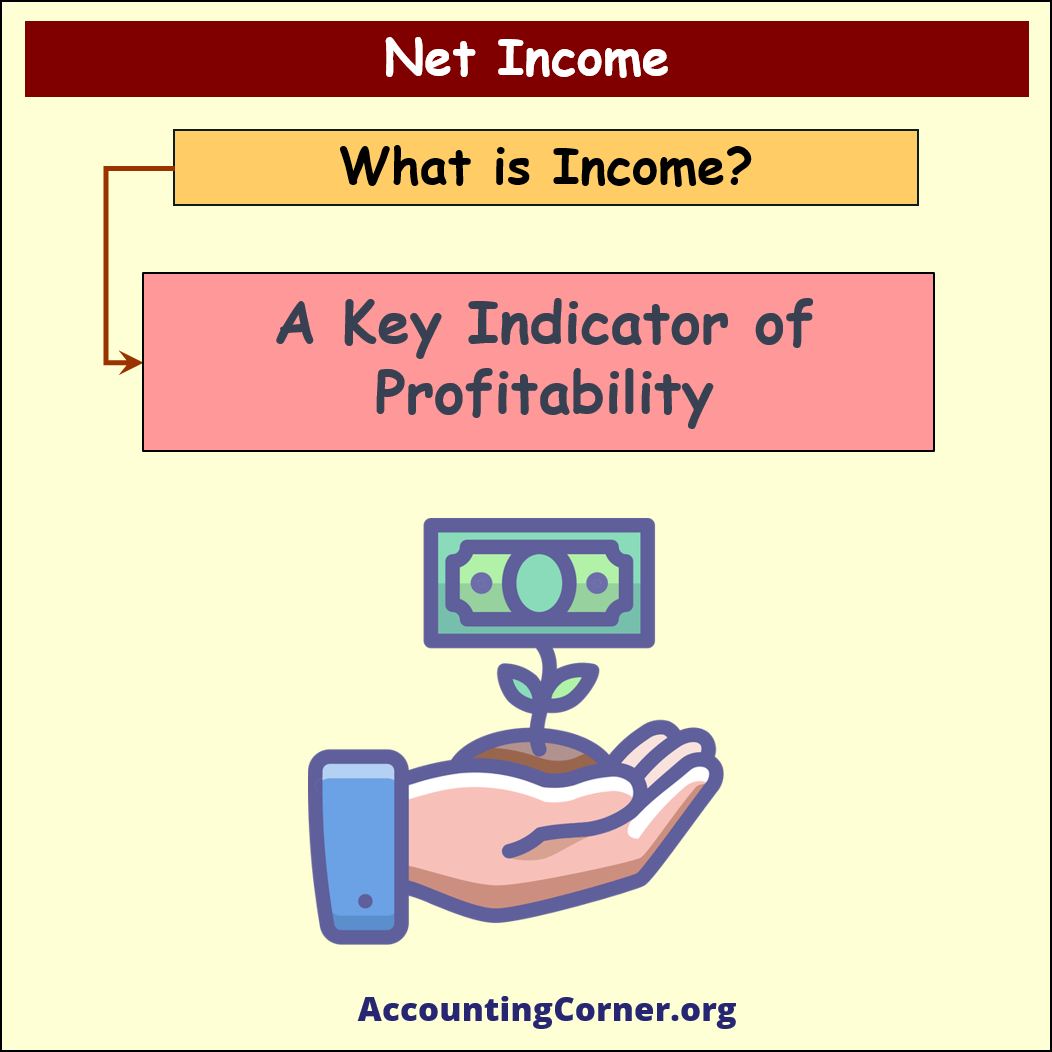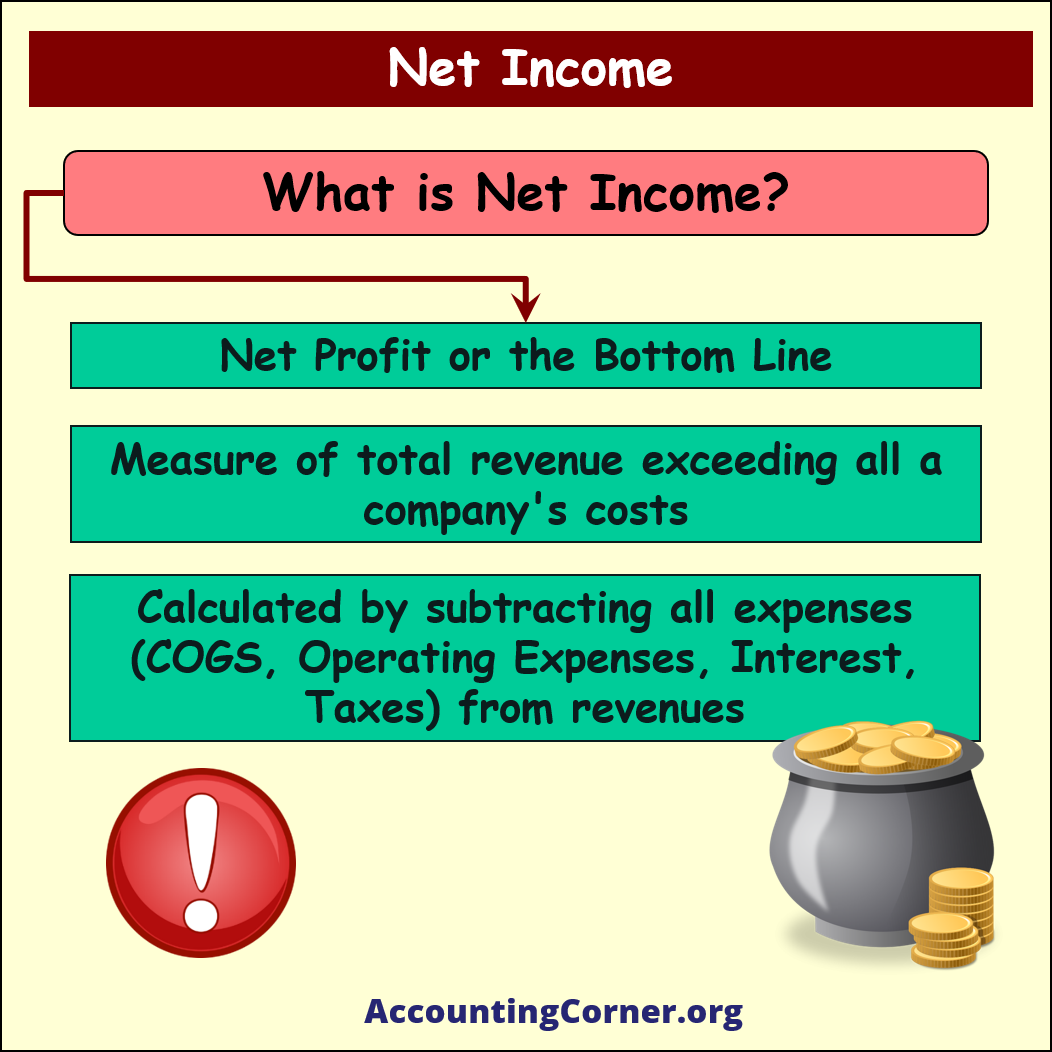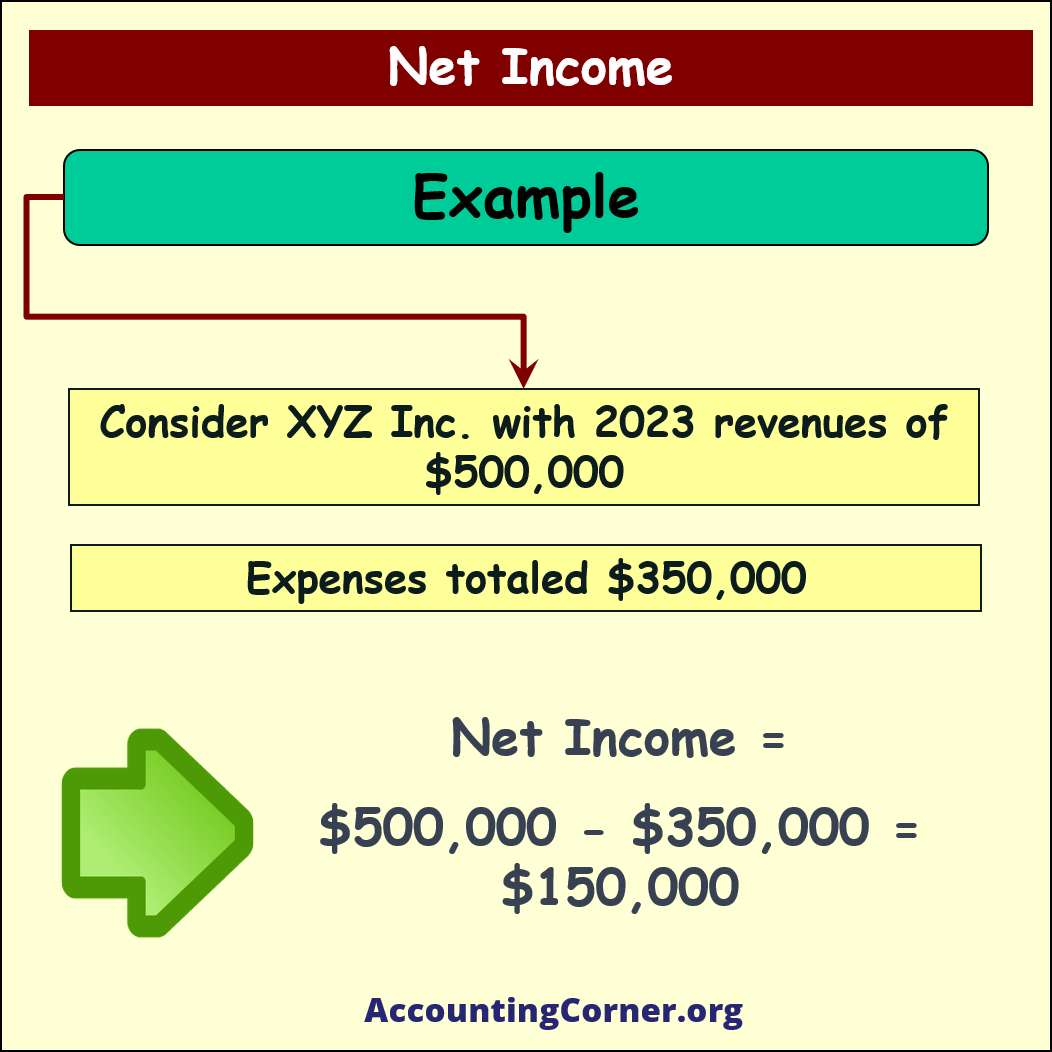Definition of Net Income:
Net income, also known as net profit or the bottom line, is the measure of total revenue that exceeds all of a company’s costs of doing business. It’s a financial metric that represents an organization’s profitability and is calculated by subtracting all operating expenses, cost of goods sold (COGS), interest, taxes, and other expenses from revenues.


Examples of Net Income:
Consider a fictional company, XYZ Inc. Suppose for the fiscal year 2023, XYZ Inc’s revenues were $500,000. Their expenses for the year were as follows:
- Cost of Goods Sold (COGS): $200,000
- Operating expenses (Rent, Salaries, Utilities etc.): $100,000
- Interest: $20,000
- Taxes: $30,000

To calculate net income, subtract all of the expenses from the revenue:
Net Income = Revenue – (COGS + Operating expenses + Interest + Taxes)
Net Income = $500,000 – ($200,000 + $100,000 + $20,000 + $30,000) = $150,000
So, XYZ Inc. made a net income or net profit of $150,000 in 2023.
Importance of Net Income:
Net income is a key indicator of a company’s financial health and efficiency. Here are a few reasons why it’s important:
- Measure of Profitability: Net income reflects the amount of revenue that remains as profit after all costs, expenses, and taxes are paid. The higher the net income, the more profitable the company is.
- Performance Evaluation: Investors and stakeholders use net income to assess the company’s performance. If a company consistently reports high net income, it’s an indication that the company is well-managed and profitable.
- Basis for Financial Ratios: Net income is used to calculate various financial ratios, like return on assets (ROA), return on equity (ROE), and earnings per share (EPS), which help in comparing the company’s performance against competitors and industry averages.
Issues and Limitations of Net Income:
Despite its importance, net income has its limitations and issues:
- Accounting Methods: Accounting practices and principles may vary between companies, influencing the way they report costs and revenues, thus affecting net income. For example, companies can choose between different methods of depreciation or inventory accounting, which can significantly impact net income.
- Non-cash Items: Certain non-cash items, such as depreciation and amortization, can affect net income, which does not necessarily reflect the company’s actual cash flow during a given period.
- Non-recurring Items: Net income can be skewed by one-time, non-recurring items like a sale of assets or a lawsuit settlement. These can artificially inflate or deflate the net income for a particular period but don’t reflect the company’s ongoing profitability.
- Ignoring Opportunity Costs: Net income doesn’t take into account opportunity costs. For example, the return that could have been earned by investing the same capital elsewhere in a different opportunity.
- Tax and Interest Expenses: Differences in tax laws and interest rates in different locations can affect net income, making comparisons between companies in different regions challenging.

Despite these limitations, net income remains a crucial measure of a company’s financial performance and stability. However, it should be analyzed in conjunction with other financial metrics for a more comprehensive understanding of a company’s financial health.
The Most Popular Accounting & Finance Topics:
- Balance Sheet
- Balance Sheet Example
- Classified Balance Sheet
- Balance Sheet Template
- Income Statement
- Income Statement Example
- Multi Step Income Statement
- Income Statement Format
- Common Size Income Statement
- Income Statement Template
- Cash Flow Statement
- Cash Flow Statement Example
- Cash Flow Statement Template
- Discounted Cash Flow
- Free Cash Flow
- Accounting Equation
- Accounting Cycle
- Accounting Principles
- Retained Earnings Statement
- Retained Earnings
- Retained Earnings Formula
- Financial Analysis
- Current Ratio Formula
- Acid Test Ratio Formula
- Cash Ratio Formula
- Debt to Income Ratio
- Debt to Equity Ratio
- Debt Ratio
- Asset Turnover Ratio
- Inventory Turnover Ratio
- Mortgage Calculator
- Mortgage Rates
- Reverse Mortgage
- Mortgage Amortization Calculator
- Gross Revenue
- Semi Monthly Meaning
- Financial Statements
- Petty Cash
- General Ledger
- Allocation Definition
- Accounts Receivable
- Impairment
- Going Concern
- Trial Balance
- Accounts Payable
- Pro Forma Meaning
- FIFO
- LIFO
- Cost of Goods Sold
- How to void a check?
- Voided Check
- Depreciation
- Face Value
- Contribution Margin Ratio
- YTD Meaning
- Accrual Accounting
- What is Gross Income?
- Net Income
- What is accounting?
- Quick Ratio
- What is an invoice?
- Prudent Definition
- Prudence Definition
- Double Entry Accounting
- Gross Profit
- Gross Profit Formula
- What is an asset?
- Gross Margin Formula
- Gross Margin
- Disbursement
- Reconciliation Definition
- Deferred Revenue
- Leverage Ratio
- Collateral Definition
- Work in Progress
- EBIT Meaning
- FOB Meaning
- Return on Assets – ROA Formula
- Marginal Cost Formula
- Marginal Revenue Formula
- Proceeds
- In Transit Meaning
- Inherent Definition
- FOB Shipping Point
- WACC Formula
- What is a Guarantor?
- Tangible Meaning
- Profit and Loss Statement Template
- Revenue Vs Profit
- FTE Meaning
- Cash Book
- Accrued Income
- Bearer Bonds
- Credit Note Meaning
- EBITA meaning
- Fictitious Assets
- Preference Shares
- Wear and Tear Meaning
- Cancelled Cheque
- Cost Sheet Format
- Provision Definition
- EBITDA Meaning
- Covenant Definition
- FICA Meaning
- Ledger Definition
- Allowance for Doubtful Accounts
- T Account / T Accounts
- Contra Account
- NOPAT Formula
- Monetary Value
- Salvage Value
- Times Interest Earned Ratio
- Intermediate Accounting
- Mortgage Rate Chart
- Opportunity Cost
- Total Asset Turnover
- Sunk Cost
- Housing Interest Rates Chart
- Additional Paid In Capital
- Obsolescence
- What is Revenue?
- What Does Per Diem Mean?
- Unearned Revenue
- Accrued Expenses
- Earnings Per Share
- Consignee
- Accumulated Depreciation
- Leashold Improvements
- Operating Margin
- Notes Payable
- Current Assets
- Liabilities
- Controller Job Description
- Define Leverage
- Journal Entry
- Productivity Definition
- Capital Expenditures
- Check Register
- What is Liquidity?
- Variable Cost
- Variable Expenses
- Cash Receipts
- Gross Profit Ratio
- Net Sales
- Return on Sales
- Fixed Expenses
- Straight Line Depreciation
- Working Capital Ratio
- Fixed Cost
- Contingent Liabilities
- Marketable Securities
- Remittance Advice
- Extrapolation Definition
- Gross Sales
- Days Sales Oustanding
- Residual Value
- Accrued Interest
- Fixed Charge Coverage Ratio
- Prime Cost
- Perpetual Inventory System
- Vouching
Return from Net Income to AccountingCorner.org

